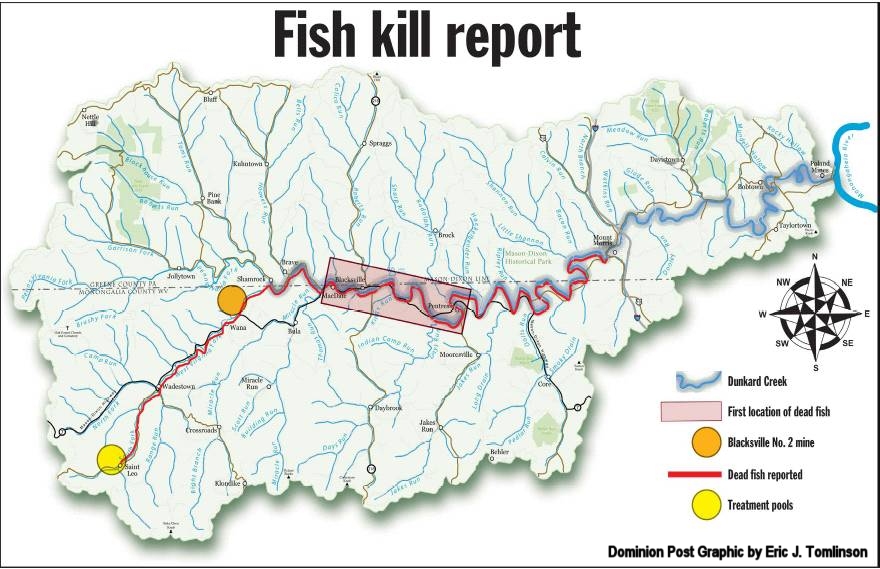Dunkard Kill Zone Expands
Most larger fish gone from creek
Morgantown Dominion
Post
2 October 2009
By David Beard
The big fish are just about gone from Dunkard Creek, although the
minnows are still active.
The kill zone extends as far upstream as St. Leo near the mouth of the
South Fork tributary, south-west of Wadestown near the Mari-on County
border; and as far down-stream as just past Mount Morris.

Frank Jernejcic, District 1 fisheries biologist for the West
Virginia
Division of Natural Resources (DNR) did not have information from the
Pennsylvania Department of Environmental Protection (DEP) about dead
fish between Mount Morris and the Monongahela River, but he noted a
portion of the creek there is already considered a dead zone because of
previous acid mine drainage.
Upstream from St. Leo, he said, he has found live fish beyond CONSOL's
Acid Mine Drainage (AMD) Treatment Station 22.
Jernejcic said he doesn't have a firm estimate yet on the number of
fish killed, but puts it in the thou-sands. "The big fish are gone,
probably starved to death," he said.
There are fewer "active spots," he said —places with large live fish,
such as bass and muskies. He's seeing live minnows though, at the
mouths of some of the creek's tributaries.
The West Virginia Department of Environmental Protection (DEP) and the
U.S. Environmental Protection Agency (EPA) are looking at golden algae
as one possible culprit, among other possibilities, for the fish kill,
but say that chlorides and TDS (total dissolved solids) from mine
drainage treatment may also play a part.
David Sternberg, EPA spokesman, said Thursday the agency is concerned
that high levels of TDS and chlorides are contributing to the algae's
growth.
And DEP spokeswoman Kathy Cosco said, "We have acknowledged that
elevated levels of chlorides and TDS are conducive to the growth of
this algae and are studying what other factors may play a role in its
proliferation."
EPA takeover?
Dunkard Creek Watershed Association President Betty Wiley said again
Thursday that the EPA should take over the investigation of the
problem, for several reasons.
One, she said, the creek zigzags across the Pennsylvania-West Virginia
border. Two, the EPA has more resources than either state DEP. And
three, she doesn't trust the West Virginia DEP's commitment to stand
against CONSOL, which has mines and acid mine drainage treatment ponds
along the creek: Blacksville No. 2 near Wana, and AMD 22.
"The DEP doesn't have the will to stand apart from politics" and do
what it needs to do to discover the problem's cause, she said.
"This goes beyond just a fish kill," Wiley said, and calls for federal
involvement. She noted a much smaller fish kill a few years ago that
led to a fine for CONSOL. "It did-
n't wipe out the whole stream."
Cosco said, "We have looked at and sampled all of CONSOL's outlets in
Dunkard Creek and consider all discharges into the Dunkard factors in
this kill."
And Sternberg said the EPA isn't interested in taking charge.
Each state has the lead in maintaining its own fisheries, he said. The
EPA merely has an oversight role.
And while the EPA does have authority in certain areas of pollution
control and federal environmental laws, this isn't a case that merits a
takeover.
He said the EPA is working with both state DEPs, and has a fresh water
biology lab in Wheeling, with
people working on the problem. Cosco described how they are cooperating.
She said the Pennsylvania DEP collected samples along the Pennsylvania
Fork, the West Virginia DEP staff have collected samples in Dunkard and
its tributaries, and the state DNR has collected data related to the
fish. "The EPA has had staff collecting information as well. All of
these agencies have been sharing information with each other during
this investigation."
Surviving and restocking
Since dying fish were first reported in early September — the first
reports originating below Pentress, according to the DEP and other
sources — experts have been trying to figure out what's causing it.
Though they now have a working idea — the algae, perhaps boosted by the
TDS and chlorides — they still don't know enough to stop it or fix it,
they said.
So when when might Dunkard Creek be clear? "That would be speculative
at this point," Sternberg said.
Wiley hopes the answer comes soon. "They have to do their home-work so
they can connect the dots."
Jernejcic has been combing the creek and tributaries, trying to
determine if any big fish are surviving upstream, and if they are
somehow instinctively avoiding making their way down to the dead zone.
He doesn't know yet.
He's kept his eye on three large fish that have been alive in the same
area for the last month.
Cosco noted, "They do have an instinct to run away, and many are
seeking refuge in the tributaries."
Scientists aren't worried, at this point, that the algae and the fish
kill will extend into the Monongahela River, she said. "The chemistry
does not suggest that the algae will not bloom in the Mon, but we are
not certain at this point."
Once the problem is solved and the creek is clean again, Jernejcic
previously said, it will take several years to manually restock it with
the larger game fish — bass and muskies — and have them reach suitable
size.
Some natural restocking will also take place, he said Thursday. Some
survivors will make their way down the tributaries, and others will
come upstream from the Mon.
